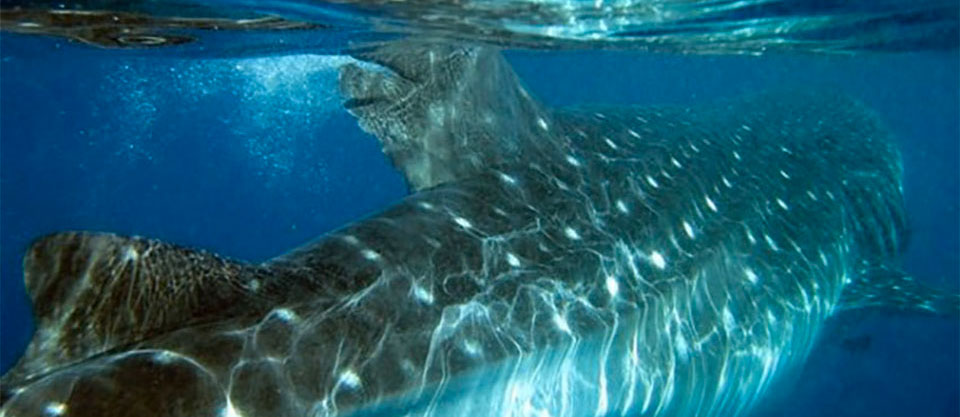Vessel Impacts
Flower Garden Banks

Why is it a concern?
Visitors, scientists, fishermen, commercial shippers, and other stakeholders of the Flower Garden Banks National Marine Sanctuary (FGBNMS) access the sanctuary through the use of recreational and commercial vessels. These vessels are an important part of the “blue economy” and also provide a safe way for many visitors to experience some of the sanctuaries most iconic places. However, there are several impacts from vessels that can impact biological and archaeological resources within the sanctuary. These impacts include ship strikes, ship groundings, lost containers from shipping vessels, and discharge of waste water and other materials.
Substantial vessel traffic, particularly by large commercial vessels, can lead to collision with and behavioral modifications of large marine mammals, turtles, or fish (primarily whale sharks). Some whale sharks within FGBNMS have shown signs of vessel strikes, in the form of scars and gouges on their bodies and fins. Mitigation techniques that employ observers, radar, sonar, and infrared detection, as well as speed reductions in high-density whale shark areas, could reduce the threat and the probability of collision.
Vessels can also introduce unwanted contaminants and waste water into sanctuary waters. More research related to ship strikes and vessel discharge could help to prevent impacts to sanctuary resources in the future.
Overview of Research
Quarterly water sampling and analysis is conducted at the sanctuary as part of the long-term monitoring projects at all banks within the sanctuary.
Research and monitoring of contaminants in FGBNMS has in the past included pre- and post-drilling surveys (using chemical analysis of sediments) to evaluate the fate and effects of their discharges on the sensitive biological assemblages inhabiting the nearby banks.
Monitoring of hydrocarbons was implemented using Semi-Permeable Membrane Devices (SPMD)s as part of the response plan for the Deepwater Horizon Blowout.
| Project Name | PI and contacts | Links |
|---|---|---|
East and West Flower Garden Banks Long-Term Monitoring |
Dr. Michelle Johnston, FGBNMS |
|
Stetson Bank Long Term Monitoring |
Marissa Nuttall, FGBNMS |
Science Needs and Questions
- Is "graywater" harmful to FGBNMS resources?
- What is the fate of corals and mesophotic communities after exposure to dispersants?
- What are the current levels of heavy metals in key biota in FGBNMS?
- What do the isotopic signatures of key biota in FGBNMS indicate regarding coastal influences?
- What are the Vessel Impacts conditions in locations identified for sanctuary expansion?
- What is the cause, and potential impact of the algae blooms occurring at McGrail, Geyer, and Bright Banks? Are these blooms occurring elsewhere?
Education and Outreach Material
Gulf of Mexico Watershed Activity (878kb pdf)
- An activity highlighting the large size of the Gulf of Mexico watershed (with answer key). Great practice in identifying and labeling the 48 contiguous states.
References
Office of National Marine Sanctuaries. 2008. Flower Garden Banks National Marine Sanctuary Condition Report 2008. U.S. Department of Commerce, National Oceanic and Atmospheric Administration, Office of National Marine Sanctuaries, Silver Spring, MD. 49 pp.
Continental Shelf Assoc., Inc. 1996. Long-term monitoring at the East and West Flower Garden Banks. OCS Study MMS 96-0046. U.S. Department of the Interior, Minerals Management Service, Gulf of Mexico OCS Region, New Orleans, Louisiana. 77 pp. + app
Dokken, Q.R., I.R. MacDonald, J.W. Tunnell, Jr., C.R. Beaver, G.S. Boland, and D.K. Hagman. 1999. Long-term monitoring at the East and West Flower Garden Banks, 1996-1997. U.S. Department of the Interior, Minerals Management Service, Gulf of Mexico OCS Region, New Orleans, Louisiana. OCS Study MMS99-0005.
Dokken, Q.R., I.R. MacDonald, J.W. Tunnell, Jr., T. Wade, K. Withers, S.J. Dilworth, T.W. Bates, C.R. Beaver, and C.M. Rigaud. 2003. Long-term monitoring at the East and West Flower Garden Banks, 1998-2001: Final Report. U.S. Department of the Interior, Minerals Management Service, Gulf of Mexico OCS Region, New Orleans, Louisiana. OCS Study MMS 2003-031. 90 pp.
Gittings, S.R. and G.S. Boland. 1991. Long-term monitoring on the Flower Garden Banks: study design and field methods. pp. 24-28 In: Proc.: Eleventh Ann. Gulf of Mexico Information Transfer Meeting. U.S. Department of the Interior, Minerals Management Service, New Orleans, Louisiana. Contract No. 14-35-0001-30499. OCS Study MMS-91-0040. 524 pp.
Gittings, S.R., G.S. Boland, K.J.P. Deslarzes, D.K. Hagman and B.S. Holland. 1992b. Long-term monitoring at the East and West Flower Garden Banks. Final Rept. OCS Study/MMS 92-006. U.S. Department of the Interior, Minerals Management Service, Gulf of Mexico OCS Regional Office, New Orleans, Louisiana. 206 pp.
Johnston, Michelle A., M.F. Nuttall, R.J. Eckert, J.A. Embesi, N.C. Slowey, E.L. Hickerson, and G.P. Schmahl. 2013. Long-term monitoring at the East and West Flower Garden Banks National Marine Sanctuary, 2009–2010, volume 2: appendices. U.S. Dept. of Interior, Bureau of Ocean Energy Management, Gulf of Mexico OCS Region, New Orleans, Louisiana. OCS Study BOEM 2013-215. 362 pp.
Precht W.F., R.B. Aronson, K.J.P. Deslarzes, M.L. Robbart, T.J.T. Murdoch, A. Gelber, D. Evans, B. Gearhart and B. Zimmer. 2010. Long-term monitoring at the East and West Flower Garden Banks, 2004-2005; Final report. U.S. Department of the Interior, Minerals Management Service, Gulf of Mexico OCS Region, New Orleans, Louisiana. OCS Study MMS.

